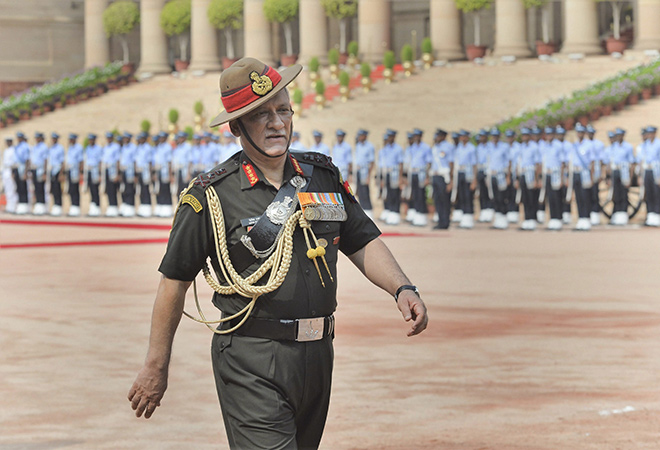
In recent days we have been witness to the rather unedifying spectacle of the Chief of Defence Staff and the Chief of Air Staff being involved in a needless public spat over the way ahead with regard to the reorganization of our higher defence organization (HDO).These discussions, should have remained confined within the South Block, but by being conducted in public domain have needlessly muddied the waters.
There are those who believe, not without reason, that this was not the appropriate time to have commenced reorganization of our HDO, given that we are in the midst of a pandemic that has gutted our economy, and more importantly, because of the ongoing military tensions with China, which show no signs of receding.
In this context, we would do well to recall the words of Dr. S N Prasad, the Chief Editor of the Official History of the 1962 Conflict with China, which incidentally, remains unpublished to this day. He concluded that the primary reason for our defeat was that the political establishment was unable to avoid a war while it was in the process of transforming the military establishment, especially its cultural orientation, something that Prime Minister Modi is also attempting to do. Indeed, the last thing we need at this juncture, is for repetition of the turmoil that existed within the Services at that time, and was undoubtedly a critically important factor in our defeat. In the circumstances that we are presently confronted with, it would be appropriate and wise to make haste slowly.
While the government needs to be complimented for having displayed the requisite political will and maturity for having finally bitten the bullet and established the post of the Chief of Defence Staff, its efforts appear not to have been fully thought through. As a result, we are attempting to institute complex reorganizations without the benefit of detailed analysis, based on impractical timelines and the whims of certain personalities. This seems apparent from the manner in which terms, such as integration, jointness and theatrization have been loosely bandied about, as well as from the simmering discontent within the Service’s hierarchies that is there for all to see. While consensus is important, the possibility that deep seated perceptions and personal agendas may cause road blocks must be taken into account and dealt with firmly. It may also be wiser to first get our terminology sorted, understand their implications, and then act accordingly.
Take the issue of the establishment of Theatre Commands that seems to be at the epicentre of all the turmoil and confusion. The reason for this uproar is not difficult to gauge, as apart from adversely impacting on the authority of the Service Chiefs, each Service is also keen on ensuring that it gets an equitable portion of the cake, in the event they are unable to stop the process. The fact that seems to have been ignored or misunderstood by all stakeholders, commentators and analysts, is that we seem to have completely misunderstood the very concept of Theatre Commands.
In our scheme of things, they are seen as integrated Headquarters that will allow us to amalgamate and replace the fourteen existing operational Single Service Commands, that are in place. Thus, we hope to ensure closer functioning among the Services, speedier decision making and financial savings by integrating logistics and by reducing the number of controlling Theatre Headquarters, to just five as per some rumours. This misunderstanding has arisen, because, given their regional orientation and tasking, the Command Headquarters have come to be incorrectly identified as Theatre Commands, with the Army Commander and his equivalent in other Services even being referred to as the C in C (Commander-in-Chief), while they are, in fact, one echelon lower.
The fact of the matter is that, as per conventional military terminology (of World War II vintage), two or more Corps sized formations are controlled by an Army, and two or more Armies are controlled by an Army Group, which also tends to be referred to as a Theatre Command. The Theatre Commander can then rightfully be referred to as the Commander- in- Chief of that Theatre because he commands all military forces located therein. If we followed the conventional hierarchy, that most Militaries adopted, we would have avoided the needless confusion that we have afflicted on ourselves. Logically speaking, then, the Theatre Commanders would be four-star Generals, who would then command a number of Armies, or their equivalent from each of the other Services. Hypothetically a North Western Theatre Command could have under command it the Northern Army and the Western Army as well as Central and Western Air Commands. The counter point is how will the Theatre Commands be operationally more efficient and effective in sharing the limited military resources likely to be available even in the future?
Off course, this raises the question as to whether such Headquarters are even required, given the fact that we have no overseas commitments and our Theatre Commands would only be adding an additional layer of bureaucracy to the existing HDO. While they would, in fact, be relieving the Service Chiefs of their operational commitments, which in our convoluted system of functioning and personality driven culture, would probably only result in more confusion and duplication of effort. Additionally, given the quantum improvements in the field of Information and Communication Technology (ICT), Automation, Artificial Intelligence, Data Analytics and Enterprise Systems, most organizations are in the process of flattening their hierarchical structures. Therefore, adding another level of command in these circumstances makes little sense.
If our intentionsare, in fact, less ambitious, and we are only looking to integrate our single service commands and thereby reduce the number of commands, then we have our work cut out. We should then be utilising the experience gleaned from the establishment of our only existing Tri-Services Command, the Andaman & Nicobar Command. This may be a more practical approach to the issue of jointness and integration. As a first step, we should then be looking at the integration of our communication, logistics, cyber, Special Operations Forces and training assets within appropriate Tri-Services Structures. This, in particular, also calls for a complete relook at our Professional Military Education syllabi, as well as our manpower and staffing policies presently in our training establishments and in our formation and service Headquarters.
Finally, our priorities appear to be misplaced as our first priority should be to undertake the integration of the Service Headquarters with the Defence Ministry. Despite the Kargil Review Committee’s recommendations in this regard, which were then endorsed by the Group of Ministers, this aspect was given short shrift with only change of nomenclature being resorted to. If we are really serious about reforming our HDO, this is the level from where we need to commence our reorganization efforts.





In total agreement with author about our misplaced priorities. Our first priority should be to undertake the integration of the Service Headquarters with the Defence Ministry. Despite the Kargil Review Committee’s recommendations and recommendations of group of ministers, only farcical change of name resorted to. Reforming our HDO has to commence with integration of Raksha Mantralaya with service headquarters.
Airforce views on process of theatrisation are valid in view of multifarious tasks, resouce crunch and inadequacy of aircrafts. The author is right, layered organisation tend to be inefficient and uneconomical but No harm taking first step towards theatrisation process, which is required. Subsequently, redundancy can be done away with. Change is always resisted, the process of transformation & change management are challenging and tedious and despite consensus not easy to implement.
Well analysed